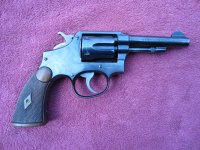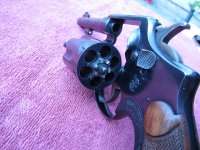Some questions:
What kind of ammunition can it handle? Scott advises against +P. Is that a consensus?
Do the grips appear to be appropriate for its vintage?
I read about "bluing" here and there but this revolver is definitely black. Would that be the original finish?
I am gathering that it is not a collector's item, so is refinishing a good or bad idea or just not worth the cost?
Regarding +P ammo, this gun was made AFTER the heat treating which IIRC happened in the 300XXX SN range. On top of that, the gun is a K frame which was designed around the 38 special. On the other hand, there is no advantage to shoot +P. Is it safe to do so on this SPECIFIC revolver? I would say yes. Would I do it? No I would not. I wouldn't because 38s are pleasant to shoot (38+ps aren't bad though) and because the gun is nice gun overall IMO.
Regarding the grips, I already answered you in post 4. IMO the gun should have pre war small silver medallion grips. The type on it were the previous type. It could be correct however. Your type was 20s and 30s and the type I am thinking of was 1930s. Your gun is 1930s vintage.
The revolver really and truthfully is not black in hue/shade. It really is blue. Its important to know the difference. Compare it to a NEW S&W, and you see the difference. To my eye, your gun is definitely original finish, and it has a blue sheen to it, depending on how you look at it / lighting, and what you are comparing it to, etc. Historically however, S&Ws blue is darker than say Colt's, but it was never black from the factory in those years. They were still doing the carbona bluing procedure which used cyanide. This was discontinued in the 1970s for safety reasons and since then, the blue has definitely been on the black(er) side. In the old days, they were blue like your gun. Its a matter of perspective and knowing what the modern bluing vs the old bluing looks like.
It is IMO a collector's item. Guns today are not made the same way. Its from a bygone era. Also compared to most, your gun is nice AND original. Its also in a handy barrel length. I would certainly buy this one over say a 1970s example so IMO it is something that a collector would rather have IE a collector's item. Its not mint NIB, nor is it rare (actually very common) but still correct and original. Any nice and original pre war S&W 5 screw is a desireable gun.
Refinishing is a bad idea for many reasons. The chief reason here is that this gun does not need it, at all. It is really nice as is, and already original. Secondly, a quality refinish will not add value to the gun, and to my eye, who knows these guns, I would know if it was redone and so would many other collectors. Also, the bluing type today is not the same, and so it cannot easily be duplicated. The gun is also not rare or valuable enough to justify a quality restoration. The only times when its ok to refinish are when perhaps you have little invested and the gun is in horrible shape, when the gun was already refinished once, or when its a rare one with condition problems. In the rare gun example, its debateable because many collectors pass over refinished guns because it will always have that stigma. You could of course want your favorite deer rifle to look better, but with these old guns, 98%+ of the time, refinishing is not worth it at all.
Do NOT fire +P ammunition in this gun. Absolutely not. It will cause greatly advanced wear.
Mike, can you clarify what you mean? IMO it would be safe to do so because of the SN range, but shooting only standard 38s in it would be smarter given its nice original condition. Is your understanding of the heat treating different than mine?



